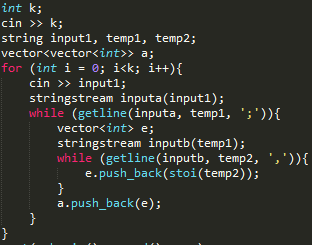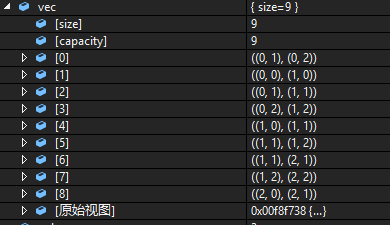您好,登錄后才能下訂單哦!
您好,登錄后才能下訂單哦!
這篇文章主要講解了“C++ stringstream格式化輸出輸入分析”,文中的講解內容簡單清晰,易于學習與理解,下面請大家跟著小編的思路慢慢深入,一起來研究和學習“C++ stringstream格式化輸出輸入分析”吧!
最近在筆試時經常遇見各種輸入問題,于是細心總結一波;首先string str; cin>>str;遇到空格結束;于是乎產生了getline(),可與得到一行字符串;空格自動去掉,只要不講cin和getline混用即可
cin.getline(s,k);
接收一行中k個字符,可以接收空格
cin.getline()實際有三個參數,cin.getline(字符串,接收個數,結束字符);
當第三個參數省略時,系統默認為 '\0' ;
getline(cin,s);
和cin.getline()類似,讀入一行字符串,值得注意的是cin.getline()屬于istream流,而getline()屬于string流,二者并不相同。
StringStream
這個東西單獨講,比較重要,包含在sstream庫中。
istringstream類用于執行C++風格的串流的輸入操作。
ostringstream類用于執行C風格的串流的輸出操作。
stringstream類同時可以支持C風格的串流的輸入輸出操作。
然后stringstream的作用就是從string對象讀取字符或字符串。
string s = "ABCD";
stringstream ss(s);
char ch;
while(ss>>ch){
cout << ch << " ";
}
//運行結果
//A B C D又例如:
string s = "hello world";
stringstream ss(s);
string str;
while(ss>>str){
cout << str << " ";
}
//運行結果
//hello world在某些題目需要處理字符串時,這些題目往往是輸入的一行中包含多個字符以及空格,這個時候就可以利用 stringstream進行單個字符或者單個字符串分析處理了
例子程序:
int main()
{
string line;
int k = 1;
cout << "===============case1================" << endl;;
while (getline(cin, line)) //可與讀到包含空格, ;等字符;但是在ss>>x時被截斷
{
int sum = 0, x;
stringstream ss(line);
while (ss >> x)
{
sum += x;
}
cout << "the sum is :" << sum << endl;
++k;
cout << endl;
cout << "===============case" << k << "================" << endl;;
}
return 0;
}-輸出:
===============case1================
1 2 3 4 5
the sum is :15===============case2================
1,2,3,4,5
the sum is :1===============case3================
1 a 2 b 3
the sum is :1===============case4================
a 1 1 1 1
the sum is :0===============case5================
另外一組:
int main()
{
string line;
int k = 1;
cout << "===============case1================" << endl;;
while (getline(cin, line))
{
string out, x;
stringstream ss(line);
while (ss >> x)
{
cout << x << ";";
}
++k;
cout << endl;
cout << "===============case" << k << "================" << endl;;
}
return 0;
}輸出:
===============case1================
this is very good!
this;is;very;good!;
===============case2================
this,is,very,good!
this,is,very,good!;
===============case3================
實驗矩陣類型的輸入:
3
0 1 2
2 3 4
5 6 7
int main()
{
string line;
int k = 1;
//測試矩陣形式的輸入:
string input;
int n;
//cin >> n; //輸入n行數據,如果后面用getline()后面的換行符不能處理
getline(cin, input);
stringstream ss(input);
ss >> n;
vector<vector<int> > vec;
for (int i = 0; i < n;i++)
{
getline(cin,input); //會將換行符當做一行
stringstream ss(input);
int x;
vector<int> temp;
while (ss>>x) //只能以空格處理分離
{
temp.push_back(x);
}
vec.push_back(temp);
}
return 0;
}使用方法:
input1是沒有空格的,帶有,;將矩陣的行列分出來;
但是使用cin>>k后,沒有使用getline(input1), 應為input1本身是沒有空格的字符串

經上面啟發:練習這樣的輸入:
3 3
0,1 0,2;0,0 1,0;0,1 1,1;0,2 1,2;1,0 1,1;1,1 1,2;1,1 2,1;1,2 2,2;2,0 2,1
測試代碼:
int main()
{
string line;
int k = 1;
int row, col;
getline(cin, line);
stringstream ss(line);
ss >> row >> col;
getline(cin, line); //第二行
stringstream s(line);
string temp1, temp2, temp3;;
vector<pair<pair<int,int>,pair<int,int>>> vec;
while (getline(s, temp1, ';'))
{
vector<pair<int, int>> pair1;
stringstream s3(temp1);
while (getline(s3, temp2,' ')) //以換行符結束,中間為空格
{
pair<int, int> pair2;
stringstream s4(temp2);
vector<int> res;
while (getline(s4, temp3, ','))
{
res.push_back(stoi(temp3));
}
pair2.first = res[0];
pair2.second = res[1];
pair1.push_back(pair2);
}
vec.push_back(make_pair(pair1[0],pair1[1]));
}
return 0;
}輸出:

另外參考輸入遇到過問題題解:
5 0
1 2 3
0 4
0 4
0 4
1 2 3
int main()
{
int N, id;
string str;
getline(cin, str);
stringstream ss(str);
ss >> N >> id;
vector<vector<int>> vec;
//for (int i = 0; i < N; i++)
//{
// vector<int> temp;
// int user;
// getline(cin, str);
// stringstream s(str);
// while (s>>user) //以空格進行劃分
// {
// temp.push_back(user);
// }
// vec.push_back(temp);
//}
while (getline(cin, str)) //其實可都可以不知道行數
{
vector<int> temp;
int user;
stringstream s(str);
while (s >> user)
{
temp.push_back(user);
}
vec.push_back(temp);
}
cout << recommendFriends(vec, id) << endl;
return 0;
}
int test()
{
//int N,id;
//cin >> N >> id; //直接輸入用戶數和需要查找的用戶id ; 這樣就會產生換行符
int N;
vector<int> in;
char c;
while ((c = cin.get()) != '\n')
{
cin.unget();
cin >> N;
in.push_back(N);
}
vector<vector<int>> vec;
for (int i = 0; i < in[0]; i++)
{
vector<int> temp;
int user;
while ((c=cin.get())!= '\n') //文件結果沒有換行符了,所以陷入死循環
{
cin.unget();
cin >> user;
temp.push_back(user);
}
if (temp.size()!=0)
{
vec.push_back(temp);
}
}
cout << recommendFriends(vec, in[1]) << endl;
return 0;
}全部代碼:
#include <iostream>
#include <algorithm>
#include <vector>
#include <unordered_map>
#include <unordered_set>
#include<sstream>
#include<fstream>
using namespace std;
#define cin infile //一定不能再oj系統中,有錯,導致超時等!!!
//C++文件輸入
ifstream infile("ini.txt", ifstream::in);
//函數功能:將輸入字符串s,以字符串c(;)進行拆分,拆分結果放在v中
//函數參數說明:s為輸入字符串;c為拆分的字符串;v為拆分結果
//函數返回值:正常返回0
int split_string(const std::string& s, std::vector<std::string>& v, const std::string& c)
{
std::string::size_type pos1, pos2;
pos2 = s.find(c);
pos1 = 0;
while (std::string::npos != pos2)
{
v.push_back(s.substr(pos1, pos2 - pos1));
pos1 = pos2 + c.size();
pos2 = s.find(c, pos1);
}
if (pos1 != s.length())
v.push_back(s.substr(pos1));
return 0;
}
int main()
{
string line;
int k = 1;
/*cout << "===============case1================" << endl;;
while (getline(cin, line))
{
int sum = 0, x;
stringstream ss(line);
while (ss >> x)
{
sum += x;
}
cout << "the sum is :" << sum << endl;
++k;
cout << endl;
cout << "===============case" << k << "================" << endl;;
}*/
//cout << "===============case1================" << endl;;
//while (getline(cin, line))
//{
// string out, x;
// stringstream ss(line);
// while (ss >> x)
// {
// cout << x << ";";
// }
// ++k;
// cout << endl;
// cout << "===============case" << k << "================" << endl;;
//}
////測試矩陣形式的輸入:
//string input;
//int n;
////cin >> n; //輸入n行數據,如果后面用getline()后面的換行符不能處理
//getline(cin, input);
//stringstream ss(input);
//ss >> n;
//
//vector<vector<int> > vec;
//for (int i = 0; i < n;i++)
//{
// getline(cin,input); //會將換行符當做一行
// stringstream ss(input);
// int x;
// vector<int> temp;
// while (ss>>x) //只能以空格處理分離
// {
// temp.push_back(x);
// }
// vec.push_back(temp);
//}
int row, col;
getline(cin, line);
stringstream ss(line);
ss >> row >> col;
getline(cin, line); //第二行
stringstream s(line);
string temp1, temp2, temp3;;
vector<pair<pair<int,int>,pair<int,int>>> vec;
while (getline(s, temp1, ';'))
{
vector<pair<int, int>> pair1;
stringstream s3(temp1);
while (getline(s3, temp2)) //以換行符結束,中間為空格
{
pair<int, int> pair2;
stringstream s4(temp2);
vector<int> res;
while (getline(s4, temp3, ','))
{
res.push_back(stoi(temp3));
}
pair2.first = res[0];
pair2.second = res[1];
pair1.push_back(pair2);
}
vec.push_back(make_pair(pair1[0],pair1[1]));
}
return 0;
}感謝各位的閱讀,以上就是“C++ stringstream格式化輸出輸入分析”的內容了,經過本文的學習后,相信大家對C++ stringstream格式化輸出輸入分析這一問題有了更深刻的體會,具體使用情況還需要大家實踐驗證。這里是億速云,小編將為大家推送更多相關知識點的文章,歡迎關注!
免責聲明:本站發布的內容(圖片、視頻和文字)以原創、轉載和分享為主,文章觀點不代表本網站立場,如果涉及侵權請聯系站長郵箱:is@yisu.com進行舉報,并提供相關證據,一經查實,將立刻刪除涉嫌侵權內容。